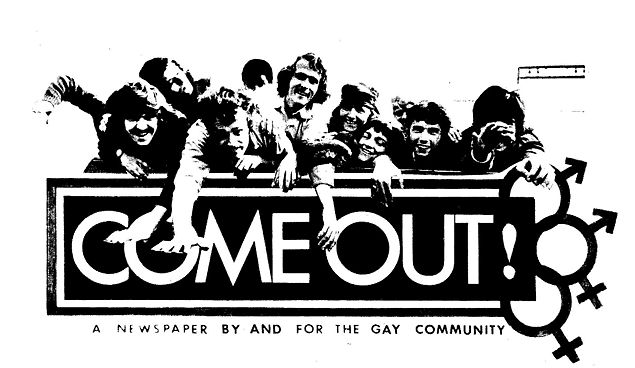Difference between revisions of "Come Out!"
| (12 intermediate revisions by 4 users not shown) | |||
| Line 1: | Line 1: | ||
| − | ''This page focuses on'' Come Out!'', the first | + | ''To read the first eight issues of ''Come Out!'' (except Issue 6), visit [[Come Out! Magazine, 1969-1972]].'' |
| + | |||
| + | |||
| + | ''This page focuses on'' Come Out!'', the first newspaper put out by the gay liberation movement. The paper was published by a small group of [[Gay Liberation Front]] members who came together in the'' Come Out! ''collective (which later became the autonomous Come Out Cell, and then the 28th of June Cell.)''<ref>Toby Marotta, ''The Politics of Homosexuality'' (Boston, MA: Houghton Mifflin Company, 1981), 105.</ref> | ||
| Line 5: | Line 8: | ||
| − | ''Come Out!'' | + | ''Come Out!'' served as a mouthpiece for the emerging gay liberation movement. The first editorial explained that the newspaper '''"dedicate[d] itself to the joy, the humor, and the dignity of the homosexual female and male. Come-out has COME OUT to fight for the freedom of the homosexual, to give voice to the rapidly growing militancy within our community, to provide a public forum for the discussion and clarification of methods and actions neccessary to end our oppression."'''<ref>''Come Out!'' 1, no. 1, Nov. 14, 1969.</ref> |
| + | |||
The paper was put together in Ellen Broidy and Linda Rhoades’ walkup in the East Village, and later in Brass’ apartment in Hell’s Kitchen. It was printed in the middle of the night by radicals who worked at a print shop in Brooklyn, and sold for merely a quarter.<ref>Perry Brass, “Sisters and Brothers: A Writer Hungering for Family Finds GLF,” in ''Smash the Church, Smash the State'', ed. Tommi Avicolli Mecca (San Francisco: City Lights Books, 2009),129-32.</ref> | The paper was put together in Ellen Broidy and Linda Rhoades’ walkup in the East Village, and later in Brass’ apartment in Hell’s Kitchen. It was printed in the middle of the night by radicals who worked at a print shop in Brooklyn, and sold for merely a quarter.<ref>Perry Brass, “Sisters and Brothers: A Writer Hungering for Family Finds GLF,” in ''Smash the Church, Smash the State'', ed. Tommi Avicolli Mecca (San Francisco: City Lights Books, 2009),129-32.</ref> | ||
| − | |||
| − | '''Perry Brass remembers his time on the paper, as well as its eventual collapse:''' | + | The 28th of June Cell faced many of the same fissures that wore on the [[Gay Liberation Front]]. Arguments erupted over how much space should be devoted to “women’s issues,” and whether street queens or people of color should have complete control over the paper.<ref>Marotta, ''Politics'', 238; Brass, “Sisters and Brothers,” 132.</ref> Although ''Come Out!'' outlived the [[Gay Liberation Front]], the paper folded in 1972 soon after GLF disbanded. |
| + | |||
| + | |||
| + | [http://www.youtube.com/watch?v=sayTsaW_IwI| '''Perry Brass remembers his time on the paper, as well as its eventual collapse:'''] | ||
| + | |||
| + | |||
| + | Return to [[Gay Liberation in New York City]]. | ||
| − | + | ===Contact=== | |
| − | + | Lindsay Branson: lindsay.branson@gmail.com | |
| − | |||
| + | ===Notes=== | ||
| + | <references/> | ||
| − | + | <comments /> | |
| − | + | [[Category:Come Out!]] | |
| + | [[Category:Gay Liberation]] | ||
| + | [[Category:Gay Liberation Front]] | ||
| + | [[Category:New York City]] | ||
| + | [[Category:Periodicals]] | ||
Latest revision as of 12:35, 28 September 2011
To read the first eight issues of Come Out! (except Issue 6), visit Come Out! Magazine, 1969-1972.
This page focuses on Come Out!, the first newspaper put out by the gay liberation movement. The paper was published by a small group of Gay Liberation Front members who came together in the Come Out! collective (which later became the autonomous Come Out Cell, and then the 28th of June Cell.)[1]
Come Out! served as a mouthpiece for the emerging gay liberation movement. The first editorial explained that the newspaper "dedicate[d] itself to the joy, the humor, and the dignity of the homosexual female and male. Come-out has COME OUT to fight for the freedom of the homosexual, to give voice to the rapidly growing militancy within our community, to provide a public forum for the discussion and clarification of methods and actions neccessary to end our oppression."[2]
The paper was put together in Ellen Broidy and Linda Rhoades’ walkup in the East Village, and later in Brass’ apartment in Hell’s Kitchen. It was printed in the middle of the night by radicals who worked at a print shop in Brooklyn, and sold for merely a quarter.[3]
The 28th of June Cell faced many of the same fissures that wore on the Gay Liberation Front. Arguments erupted over how much space should be devoted to “women’s issues,” and whether street queens or people of color should have complete control over the paper.[4] Although Come Out! outlived the Gay Liberation Front, the paper folded in 1972 soon after GLF disbanded.
Perry Brass remembers his time on the paper, as well as its eventual collapse:
Return to Gay Liberation in New York City.
Contact
Lindsay Branson: lindsay.branson@gmail.com
Notes
- ↑ Toby Marotta, The Politics of Homosexuality (Boston, MA: Houghton Mifflin Company, 1981), 105.
- ↑ Come Out! 1, no. 1, Nov. 14, 1969.
- ↑ Perry Brass, “Sisters and Brothers: A Writer Hungering for Family Finds GLF,” in Smash the Church, Smash the State, ed. Tommi Avicolli Mecca (San Francisco: City Lights Books, 2009),129-32.
- ↑ Marotta, Politics, 238; Brass, “Sisters and Brothers,” 132.
<comments />
